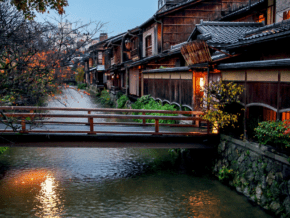Whether you're an avid adventurer, a curious traveler, or someone seeking a spiritual escape, Mount Fuji belongs on every Japan itinerary. Fujisan is not only Japan's highest peak but also an iconic symbol of the country. A day trip to its vicinity offers a glimpse of its breathtaking beauty and the rich culture surrounding it.
In this extensive guide, we’ll go over the essentials of planning a Mount Fuji day trip. You'll discover your transportation options, things to do, safety tips, and more, so you can make sure it’s going to be a fun trip to remember.
How to get to Mount Fuji from Tokyo
Planning your day trip to Mount Fuji begins with figuring out how to get there, and if you're in Tokyo, the most convenient way to get there is by train. Tokyo serves as the nearest major hub to this natural wonder.
Most people take the train from Tokyo's Shinjuku station and get off at either Kawaguchiko or Fujisan stations. The 2-2.5-hour train ride helps you decompress from the bustling metropolis to the serene surroundings of Mount Fuji.
ⓘ PRO TIP: If you're taking the Tokyo to Kyoto bullet train during the summer, book a seat on the right side if you're departing from Tokyo and the left side if you're traveling from Kyoto. You'll get an impressive view of Mount Fuji from the Shinkansen.
If you're on a budget, take the bus. The Fujikyuko Express Bus runs from Tokyo's Shinjuku Station to Kawaguchiko Station near Mount Fuji. From there, you can catch local buses to explore nearby attractions or even ascend Mount Fuji to the 5th station. A one-way adult ticket costs 1,800 JPY if you book online (1,950 JPY at the counter).
There are also companies that offer exclusive tours of the area. A day trip from Tokyo to Mt Fuji can cost between 40,000 yen to 80,000 yen depending on the number of tourist spots that you will visit, and whether it's a private or group tour.
Whichever way you choose to get to Mt Fuji, it's smart to book ahead. Seats are limited, especially during tourist season.
Mount Fuji things to do
Every day trip from Tokyo will head to either the Fuji Five Lakes region or Hakone. While both destinations highlight the beauty of Mount Fuji, the Fuji Five Lakes region emphasizes natural beauty and outdoor adventures, while Hakone offers a blend of hot springs and cultural attractions.
Choosing between the two depends on your preferences, but I chose Fuji Five Lakes, On a clear day, it's the best place to see Mt Fuji.
Lake Kawaguchi
Your day trip to Mount Fuji opens a treasure trove of activities and sights that will leave you awestruck. One of the top attractions in the vicinity of Mount Fuji is Lake Kawaguchi.
This beautiful lake, one of the five that grace the mountain's base, offers a multitude of recreational activities. You can opt for boat rides on Kawaguchiko, soak in hot spring baths (onsen), and relish the stunning views of the mountain. It's a splendid location for relaxation and rejuvenation, enabling you to connect with nature on a deeper level.
Chureito Pagoda
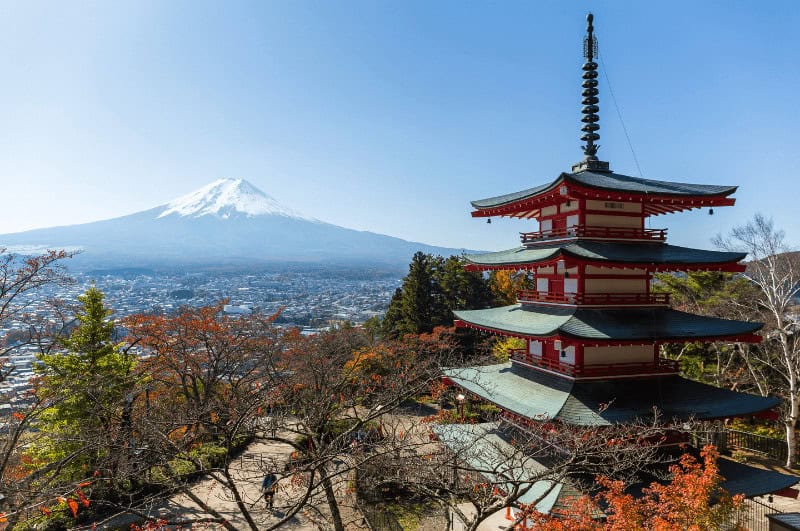
Fuji Five Lakes, nestled in the shadow of Mount Fuji, is home to numerous shrines and temples. This includes the Chureito Pagoda, situated on the grounds of the Arakura Sengen Shrine. This pagoda provides a stunning and iconic view of Mount Fuji, making it an essential stop for any traveler looking to capture that picture-perfect moment.
You'll have to prepare your body though, because getting to the observation deck will require you to climb about 398 steps. The journey takes about 15 to 20 minutes.
ⓘ PRO TIP: If you want to discover local culture, also visit the Fujiyoshida Sengen Shrine. The shrine holds important festivals and rituals related to Mount Fuji. Participating in these ceremonies can provide a unique and meaningful perspective on the mountain's significance in Japanese culture.
Oshino Hakkai
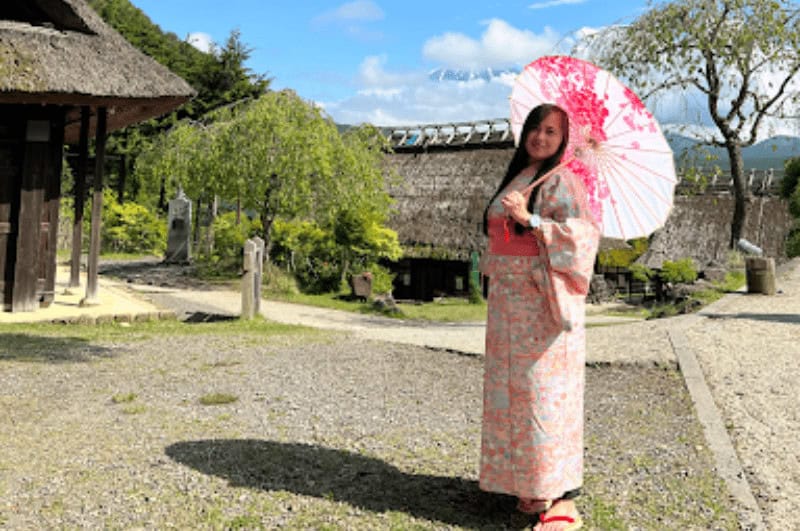
Located near Mount Fuji, Oshino Hakkai is a traditional village that is a part of the Mt. Fuji World Heritage Site. Oshino Hakkai allows you to see and walk by eight ponds that were formed after historic eruptions and intense volcanic activity.
The area features traditional village houses, shops, and watermills set against a spectacular backdrop of Japan’s most famous mountain. After touring the ponds and visiting the Hannoki Bayashi Shiryokan open-air museum, you can grab some snacks at small food stands that sell grilled sweetfish or mochi skewers.
Hiking on Mount Fuji
One of the most popular hiking options for day-trippers is the Yoshida Trail. This trail takes you to Fuji 5th Station, which is a significant point of interest for many visitors. Here, you can experience the breathtaking views, take photographs, and immerse yourself in the serene beauty of the surrounding landscape.
An alternative hiking option is the Gotemba Trail. This route is somewhat less crowded, which makes it an attractive choice for those who prefer solitude in the embrace of nature. The Gotemba Trail allows you to explore the wilderness of Mount Fuji without the bustling crowds often found on the more popular trails.
Kachi Kachi Ropeway (Fuji Panoramic Ropeway)
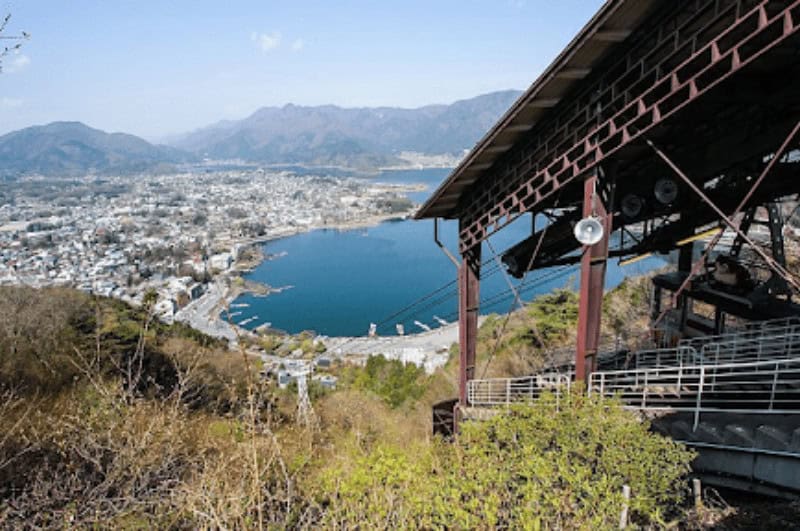
For those seeking a more panoramic perspective, the Kachi Kachi Ropeway provides an ideal vantage point. This cable car takes you to Tenjo-Yama Park, situated at the eastern edge of Lake Kawaguchi.
From this elevated position, you can enjoy remarkable, 360-degree views of Mount Fuji and the sprawling landscape that surrounds it. It's a picturesque spot to capture the grandeur of the mountain in its entirety.
Admire the flowers at the Fuji Shibazakura Festival
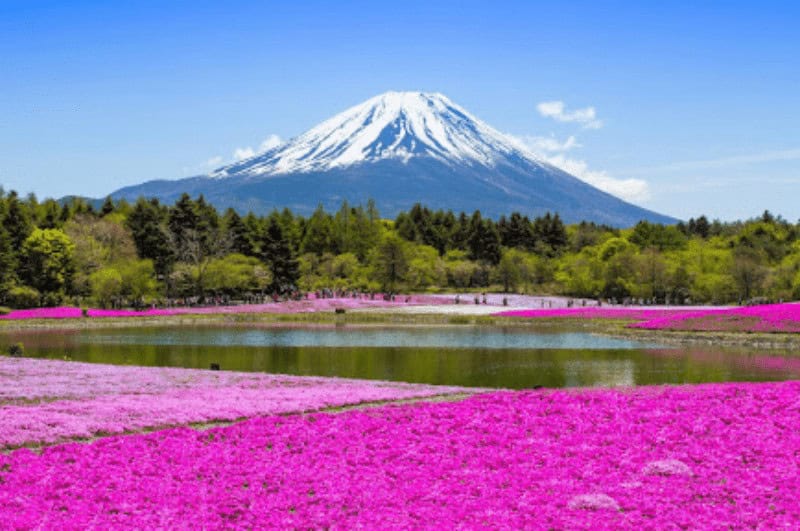
If you love flowers and you’re visiting between April and mid-May, one of the spots that offer a beautiful view of Mt Fuji is Fuji Motosuko Resort. Lying on the shore of Lake Motosuko, this is where the Fuji Shibazakura Festival is held every year.
The resort has vast fields of shibazakura (moss phlox) flowers. These flowers bloom in various shades, including pink, white, and purple, creating a stunning carpet-like appearance against the backdrop of Mt. Fuji.
You can also enjoy the cool breeze and drink a cup of coffee while admiring the flowers surrounding the resort.
Fuji Q Highland
If you're traveling with a group or your family and want to inject some excitement into your day, put Fuji Q Highland on your itinerary.
This amusement park, nestled near Lake Kawaguchi, boasts a plethora of thrilling rides and attractions that cater to all age groups. From roller coasters that defy gravity to interactive exhibits, Fuji Q Highland promises a day filled with excitement and exhilaration.
A trip to Mt Fuji won’t be complete without visiting the Gotemba Premium Outlets. Before heading back to Tokyo or anywhere else, you may want to shop for shoes, bags, clothes, perfume, or other essentials from the outlet.
Japan offers tax-free shopping for foreigners, and you may be able to find limited edition bags or shoes from designer brands like Gucci, Manolo Blahnik, Balenciaga, and Chloe.
Outlet shoppers can also enjoy views of Mount Fuji from the Gotemba Premium Outlets. If you missed the view of the mountain all throughout the day, your trip to the outlets may offer you a last chance to have a glimpse of Mt Fuji.
Best time to visit Mt Fuji
Late spring to early autumn, spanning from July to September, is considered the prime period to visit. During these months, the snow has melted, and the trails leading to the mountain's summit are accessible.
I recommend starting your journey early in the morning. Doing so not only allows you to maximize your time exploring the awe-inspiring surroundings but also provides the opportunity to witness Mount Fuji at its most pristine.
Morning hours are typically characterized by clearer skies and less cloud cover, so you'll have an unobstructed view of the majestic peak.
One tip to ensure that you will be able to see Mt Fuji is to schedule your tour when the weather is sunny. Be sure to monitor the weather forecasts days before your trip or else you will miss the view of the famous mountain.
Starting your trip early in the morning will give you more chances of seeing the mountain late in the afternoon or just before you head to Gotemba Outlet to shop.
Mt Fuji day trip essentials
Packing wisely is a crucial aspect of planning a Mount Fuji day trip. To ensure your journey is comfortable and hassle-free, consider the following essentials:
- Comfortable shoes – Since your day trip may involve walking, comfortable footwear is a must. Make sure your shoes are suited to the type of activities you plan to engage in.
- Weather-appropriate clothing – Japanese weather can be quite variable, so layering is essential. In cooler months, having warm clothing options is necessary. Conversely, during the summer, it's vital to bring sun protection, including hats and sunscreen, to shield yourself from the sun's rays.
- Water and snacks – Staying hydrated is essential. Carry a water bottle and some snacks to maintain your energy levels throughout the day.
- Camera – Don't forget to bring a camera or smartphone to capture the breathtaking views and unforgettable moments of your Mount Fuji day trip. The scenery is so stunning that you'll undoubtedly want to record it for posterity.
Where and what to eat
Exploring the culinary offerings of the Mount Fuji area is your chance to savor local delicacies and experience the unique flavors of the area. Be sure to try regional specialties like Hoto, a dish made from thick udon noodles, and Fujinomiya yakisoba, which is a delectable, stir-fried noodle dish that showcases local culinary craftsmanship.
As you venture around the Five Lakes region and Lake Kawaguchi, you'll discover numerous restaurants and eateries that offer a variety of dining options, from traditional Japanese cuisine to international fare. Don't worry, there's something to satisfy every palate.
In addition to sit-down restaurants, you can also explore local snacks that are emblematic of the region. These might include Fujiyama cookies, a delightful treat with an amusing name, or indulging in Mount Fuji-shaped ice cream that's as delicious as it is Instagram-worthy.
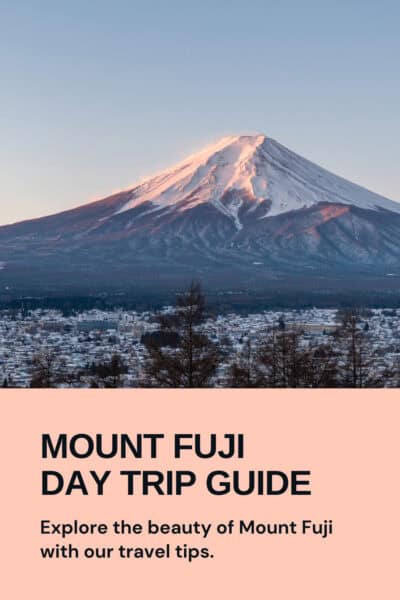
Traditional Japanese culture
Japan is renowned for its commitment to cleanliness and its deeply ingrained cultural customs. When visiting the region around Mount Fuji, it's essential to respect these customs to ensure a positive and respectful experience for both you and the locals.
One important aspect of this is proper trash disposal. Japan is notorious for its clean streets, and this is maintained by a strong culture of personal responsibility. As such, it's essential to carry your trash with you until you find a suitable disposal bin. This is a small gesture that goes a long way in preserving the pristine beauty of the area.
Additionally, when visiting shrines and temples, it's important to be aware of and follow local customs. This might include bowing, clapping, and showing respect in other ways. Not only will doing these help you to adhere to local etiquette, but it will also give you a deeper appreciation for the spiritual significance of these sites.
Mount Fuji safety tips
Safety is a top priority when exploring Mount Fuji, even if you're only on a day trip. The weather around Mount Fuji can change rapidly, especially at higher altitudes. Keeping an eye on the weather forecast before and during your trip is essential. Be prepared to adjust your plans if unfavorable weather conditions arise.
If you plan to hike to higher elevations on Mount Fuji, such as the 5th Station, be aware of the symptoms of altitude sickness. These may include headaches, nausea, and dizziness. Staying hydrated and taking regular breaks can help reduce these effects.
Takeaway
With the right preparations and a respectful attitude toward local customs, your day trip to Mount Fuji is sure to be an unforgettable adventure in the Land of the Rising Sun. While a day trip isn’t really enough to explore the area, the breathtaking vistas, unique culinary delights, and spiritual encounters will leave you with cherished memories that last a lifetime.
So, pack your bags, plan your journey, and enjoy your day trip to one of the most beautiful spots in Japan.
Angeline Licerio is a blogger from Dollarmize, a website that helps people make money online. When she’s not writing a blog about side hustles or freelancing, she is busy traveling throughout Asia.

